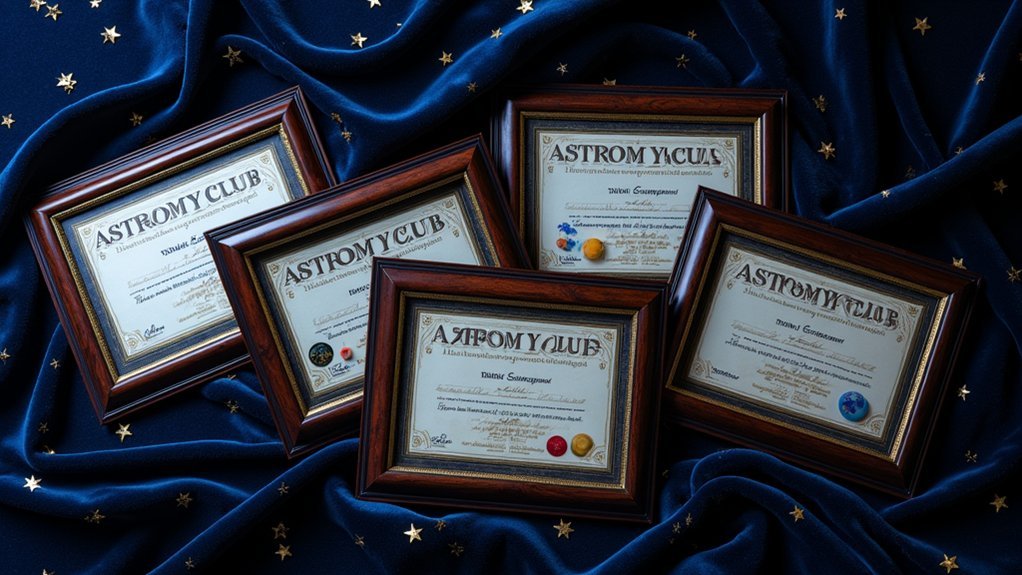The night sky’s most dazzling stars include Sirius (magnitude -1.46), Canopus (-0.74), and Arcturus (-0.05). You’ll find Sirius dominating winter skies in the Northern Hemisphere, while Canopus shines brilliantly in the Southern Hemisphere. These celestial beacons vary in color from blue-white to orange, revealing their temperature and life stage. Star brightness depends on both their intrinsic luminosity and distance from Earth. Discover how these cosmic jewels can guide your stargazing adventures.
Understanding Star Brightness and the Magnitude Scale

How can we measure the dazzling points of light that pepper our night sky? Astronomers use the magnitude scale, where counterintuitively, lower numbers indicate brighter stars. Sirius, the night sky’s brightest star, shines at -1.46 on this scale.
You’ll find the magnitude scale works logarithmically—a difference of 5 magnitudes equals a brightness factor of 100. This means a magnitude 1 star appears 100 times brighter than a magnitude 6 star.
When you observe stars of different colors, you’re seeing temperature variations. Blue O-type stars burn hottest and brightest, while cooler red M-type stars appear fainter.
Our Sun, a G2 star, blazes at magnitude -26.74.
Remember that a star’s apparent brightness also depends on its distance from Earth.
The Physics Behind Star Colors and Their Meaning
When you observe stars of different colors in the night sky, you’re actually witnessing variations in their surface temperatures, with blue stars burning hottest at over 30,000 K and red stars coolest at under 3,500 K.
These colors aren’t just pretty displays—they reveal the star’s chemical composition through spectral lines that act like fingerprints, allowing astronomers to identify elements present in the stellar atmosphere.
The color also tells you about a star’s life stage and expected longevity, as hotter blue stars burn through their fuel rapidly and live shorter lives, while cooler red stars conserve their energy and can shine for billions of years.
Color Temperature Basics
Though seemingly simple, a star’s color reveals profound information about its fundamental properties and life cycle. When you observe stars, you’re witnessing their color temperature—a direct indicator of their surface conditions.
The spectral classification system (O, B, A, F, G, K, M) organizes stars from hottest to coolest, with each letter accompanied by a number from 0-9 for finer distinction.
Our Sun, not the brightest object in the night sky, falls into the G2 category with a yellowish appearance and surface temperature around 5,500 K.
Wien’s displacement law helps astronomers determine a star’s temperature by measuring the peak wavelength of its radiation.
Blue stars burn hottest at over 30,000 K but die quickly, while cooler red stars below 3,500 K can shine for billions of years.
Element Fingerprints Revealed
Beyond temperature readings, star colors serve as cosmic spectroscopic fingerprints that reveal their elemental makeup.
When you observe a star’s spectrum, you’re witnessing absorption lines that correspond to specific elements—hydrogen, helium, and various metals—present in its atmosphere.
Astronomers classify stars into spectral types (O, B, A, F, G, K, and M) with numerical subdivisions (0-9) that precisely categorize their chemical composition.
Our Sun, a G2 star, falls midway in this classification system.
The relationship between a star’s brightness and its spectral characteristics isn’t coincidental; temperature directly influences how bright a star appears.
Lifespan Stage Indicators
Star colors function as celestial timepieces, revealing not just temperature but also a star’s current life stage. When you observe the night sky, you’re witnessing stars at different points in their cosmic journeys, with color offering essential clues about their development.
- Blue giants burn intensely hot (10,000+ K) but have the shortest lifespan, exhausting their fuel in mere millions of years despite their dazzling brightness.
- Yellow stars like our Sun (5,000-7,500 K) represent middle-aged stars with moderate temperature and billions of years of life remaining.
- Orange dwarfs (3,500-5,000 K) burn their fuel slowly, enjoying lifespans potentially exceeding our Sun’s.
- Red supergiants like Betelgeuse indicate aging stars that have expanded and cooled, signaling they’re approaching their spectacular end through supernova.
Sirius: The Night Sky’s Brightest Jewel
Gleaming with unmatched brilliance, Sirius dominates our night sky as its brightest stellar object. With an apparent magnitude of -1.46, this dazzling jewel sits just 8.6 light-years away in the constellation Canis Major.
You’ll easily spot Sirius during winter evenings in the Northern Hemisphere, rising in the east and setting westward by early evening.
This “glowing” star (as its Greek name suggests) is actually a binary system—Sirius A outshines its white dwarf companion, Sirius B, by a factor of 10,000.
Throughout history, cultures worldwide have connected this star to dogs, agriculture, and seasonal timing. Its exceptional brightness results from both its intrinsic luminosity and proximity to Earth, making it an invaluable reference point when you’re charting the night sky.
Canopus and Arcturus: Navigational Beacons Across Hemispheres

When traversing the celestial sphere, you’ll find two stellar giants standing out across opposite hemispheres: Canopus and Arcturus.
These navigational beacons have guided mariners and stargazers for centuries across their respective domains.
You can distinguish these celestial landmarks by:
- Brightness – Canopus shines at -0.74 magnitude as the night sky’s second-brightest star, while Arcturus glows at -0.05 as the fourth-brightest.
- Location – Canopus dominates the Southern Hemisphere at 313 light-years away, with Arcturus ruling northern skies just 34 light-years distant.
- Viewing season – You’ll spot Canopus best in February, while Arcturus commands spring and summer nights.
- Finding method – Locate Arcturus by following the Big Dipper’s handle arc; find Canopus by its steady brilliance in Carina.
Vega and the Summer Triangle: A Stargazing Highlight
If you direct your gaze skyward on summer evenings, you’ll encounter one of the most magnificent asterisms in the night sky—the Summer Triangle.
At its brightest corner sits Vega, the fifth-brightest star visible from Earth, shining with a striking visual magnitude of +0.03.
Located just 25 light-years away, this relatively young star—only 450 million years old—spins rapidly, completing a full rotation in merely 12.5 hours.
As part of the Summer Triangle alongside Altair and Deneb, Vega dominates northern hemisphere skies throughout summer.
This A0 spectral type main sequence star serves as an invaluable reference point when you’re traversing the cosmos.
Use Vega’s prominent position to orient yourself and locate other celestial treasures during your stargazing adventures.
Alpha Centauri: Our Closest Stellar Neighbor

You’ll be amazed by Alpha Centauri, a triple star system consisting of two Sun-like stars and a red dwarf, located just 4.37 light-years from Earth.
This stellar neighborhood treasure includes Proxima Centauri, which hosts an exoplanet in its habitable zone, making it a target of intense scientific interest.
If you’re in the Southern Hemisphere, particularly Australia, you can spot this remarkable system shining brightly in the night sky without special equipment.
Triple Star System
Just beyond our celestial doorstep lies Alpha Centauri, the closest star system to Earth at a mere 4.3 light-years away.
This fascinating triple star system contains three distinct stellar bodies that you can think of as our cosmic neighbors.
What makes Alpha Centauri remarkable:
- The system features a binary pair—Alpha Centauri A (a Sun-like G-type star) and Alpha Centauri B (a slightly cooler K-type star)—that orbit each other every 79.91 years.
- Proxima Centauri, a red dwarf, is actually the closest individual star to our Sun at 4.24 light-years.
- Proxima hosts at least two exoplanets, with Proxima Centauri b located in the habitable zone.
- The entire system represents humanity’s most promising target for future interstellar exploration.
Only 4.37 Light-Years
While we’ve explored the fascinating triple-star nature of Alpha Centauri, the true wonder lies in its remarkable proximity to our home planet.
At just 4.37 light-years away from us, Alpha Centauri stands as our closest stellar neighbor in the vast cosmic neighborhood.
What’s even more impressive is that Proxima Centauri, the smallest member of this stellar family, sits closer still at 4.24 light-years from Earth, making it our sun’s nearest known stellar companion.
Despite this relative closeness, you can’t easily spot the system as individual stars without telescopic aid.
Alpha Centauri A and B dance around each other in an elegant cosmic ballet that takes nearly 80 years to complete, while Proxima orbits the pair from a distance – all practically in our cosmic backyard.
Southern Hemisphere View
Stargazers in the Southern Hemisphere enjoy a privileged view of Alpha Centauri that their northern counterparts can only envy.
Australia offers particularly spectacular viewing opportunities of our nearest stellar neighbor in the constellation Centaurus.
When observing Alpha Centauri in the southern night sky, you’ll notice:
- The system appears as the third brightest star in the night sky, making it easily identifiable without optical aids.
- Alpha Centauri A and B are visible as a single point of light to the naked eye.
- The binary stars orbit each other in an elliptical pattern, completing one orbit every 80 years.
- Proxima Centauri, though closest to Earth at 4.3 light-years away, requires a telescope to see due to its dimness.
Seasonal Visibility of Prominent Stars

As Earth travels through its annual journey around the sun, the night sky transforms dramatically, revealing different stellar performers throughout the year. In the Northern Hemisphere, you’ll find Sirius dominating winter skies, while Vega becomes the highlight during summer months.
Winter stargazing offers views of Aldebaran in Taurus and bright Rigel in Orion.
As spring emerges, Arcturus in Boötes takes center stage, shining prominently through early summer. By midsummer, the famous Summer Triangle formed by Vega, Deneb, and Altair serves as an excellent navigation tool for locating other celestial objects.
The seasonal visibility of bright stars isn’t just about which stars appear—their perceived brightness also varies seasonally.
Plan your observations according to these yearly cycles to experience the full range of dazzling stars.
Using Star Charts and Apps to Locate Bright Stars
You’ll master star-hopping by using traditional charts to navigate from familiar constellations to harder-to-find bright stars nearby.
Digital apps now transform your smartphone into a pocket planetarium that identifies celestial objects when you point your device skyward.
These technological tools offer enhanced precision through GPS and time-specific data, making stargazing more accessible even from light-polluted urban areas.
Star-Hopping Fundamentals
While the night sky might initially appear as a chaotic scatter of stars, learning to navigate it’s straightforward with the right tools and techniques.
Star-hopping is an effective method that uses bright stars as stepping stones to locate fainter objects.
To master this technique:
- Start with identifying major constellations like Orion or the Big Dipper, which serve as your celestial landmarks.
- Select a bright star within your chosen constellation as your starting point.
- Use star charts or mobile apps to visualize the path from your reference star to your target.
- Gradually move your gaze along this imaginary line, hopping from one star to the next until you reach your destination.
Combining traditional charts with augmented reality apps will greatly enhance your ability to traverse the night sky.
Digital Sky Navigation
In today’s digital age, exploring the night sky has become remarkably accessible through powerful smartphone apps and computerized star charts. You’ll find star navigation apps like SkyView, Star Walk, and Night Sky transform your device into a window to the cosmos, helping you instantly identify bright stars and constellations from your location.
These digital star charts utilize augmented reality technology—simply point your phone skyward to see labeled celestial objects appear on your screen in real-time. You can customize your viewing experience by adjusting date and time settings, allowing you to plan stargazing sessions during ideal visibility periods.
Beyond just locating stars, these apps provide educational content about star brightness, classification, and cultural significance, enhancing your astronomical knowledge while making stargazing more engaging and informative.
The Role of Light Pollution in Star Visibility

As cities expand with their glowing streetlights and illuminated buildings, the natural majesty of our night sky gradually disappears.
Light pollution has dramatically reduced the visibility of stars you can observe, with profound effects on your stargazing experience.
Our modern glow has stolen the night, turning once-celestial skies into dim shadows of cosmic wonder.
Consider these stark contrasts:
- In truly dark locations, you can see over 2,000,000 celestial objects, while urban dwellers glimpse only about 2,500 stars.
- Approximately 80% of people worldwide live under light-polluted skies.
- Even bright constellations become difficult to identify in urban environments.
- Observatories near populated areas face serious limitations in research capabilities.
You can help restore the night sky’s brilliance by supporting dark sky reserves and using properly shielded outdoor lighting, allowing both you and future generations to experience the universe’s true splendor.
Observing Bright Stars With Binoculars and Small Telescopes
Once you’ve located a dark spot away from the city’s glow, you’re ready to explore the celestial treasures with your own equipment.
Binoculars offer an excellent introduction to stargazing, providing a wider field of view that’s perfect for observing bright stars like Sirius and Vega. For steady viewing, mount your binoculars on a tripod to eliminate hand tremors.
Small telescopes take your experience further by revealing subtle details of stars such as Rigel and Betelgeuse, including their distinctive colors and characteristics.
These instruments gather more light than the naked eye, making fainter stars like Procyon suddenly pop against the dark background.
Remember that location matters—the further you’re from city lights, the more brilliant these dazzling stars will appear through either instrument.
Frequently Asked Questions
What Is the Night Sky Most Shining Star?
Sirius, also known as the Dog Star, is the night sky’s most shining star. You’ll find it in Canis Major, about 8.6 light-years away. It’s a binary system that’s visible winter nights.
What Are the 3 Brightest Stars in the Night Sky?
The 3 brightest stars you’ll see in the night sky are Sirius (-1.46 magnitude) in Canis Major, Canopus (-0.74 magnitude) in Carina, and Arcturus (-0.05 magnitude) in Boötes. They’re visible from different hemispheres.
What Is the Most Common Star in the Night Sky?
You’ll find red dwarfs are the most common stars in our night sky, making up 70-80% of the Milky Way’s stars. Despite their abundance, you can’t see these small, cool stars without a telescope.
What Is the Top 10 Brightest Star?
You’ll find Sirius at the top of the brightest stars list, followed by Canopus, Alpha Centauri, Arcturus, and Vega. The remaining five include Capella, Rigel, Procyon, Achernar, and Betelgeuse.
In Summary
You’ll find the night sky’s brightest stars offer more than just stunning views—they’re gateways to understanding our universe. Whether you’re tracking Sirius’s brilliant blue-white glow or admiring Arcturus’s golden hue, each star tells a cosmic story. With basic equipment and the right conditions, you’re never far from experiencing these celestial marvels. Take time to learn their patterns and you’ll navigate the heavens like ancient explorers.





Leave a Reply